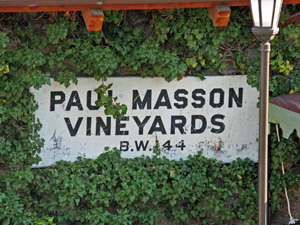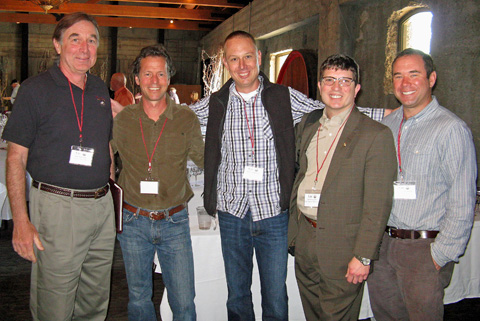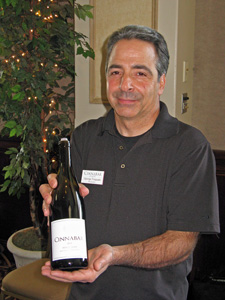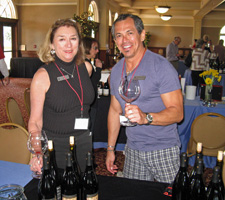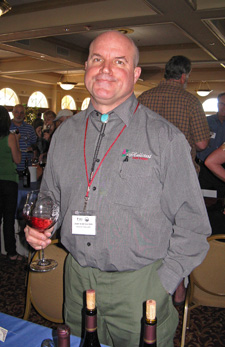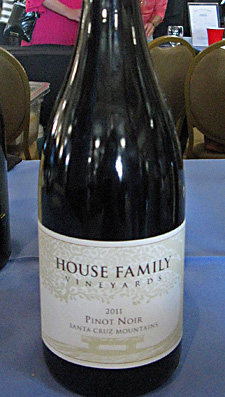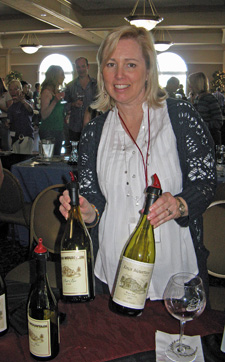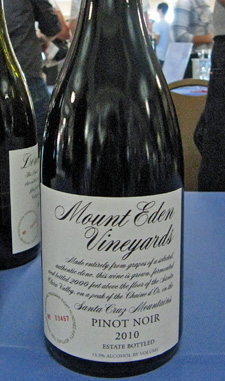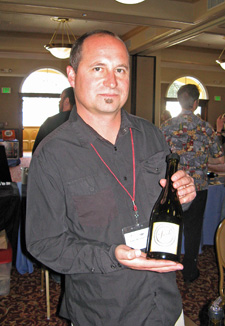Alfaro Family Vineyards
Alfaro 2010 Pinot Noir, Alfaro Family Vineyard Estate, Santa Cruz Mountains. Aged in 50% new French oak. Medium-light color, with bright cherry and earth aromas along with undertones of sweet oak. Lively mouthfeel and medium tannins.
Alfaro 2011 Pinot Noir, Lester Family Vineyard, Santa Cruz Mountains. From 2A, 23, 37, 115, 667, and 777 clones. Slightly lighter garnet color, featuring more strawberry and spice along with earth and slightly floral notes plus a touch of vanilla/oak. Juicy acidity and moderate tannins on the finish, nice.
Bargetto Winery
Bargetto 2010 Pinot Noir, Santa Cruz Mountains. Sourced from three Pinot clones at Bargetto’s estate Regan Vineyard, plus 2% Zinfandel from Lodi’s Silvaspoons Vineyard. Medium-light color, this showed an oaky nose along with red fruits and spice. Medium-bodied with a slightly rough tannic finish.
Bargetto 2010 Pinot Noir, “Mount Eden Clone,” Estate, Santa Cruz Mountains. Slightly deeper color, displaying darker fruit, spice, a touch of pepper, all framed by a substantial dose of vanilla/oak. Bigger in texture than the previous wine with moderate tannins.
Beauregard Vineyards
Beauregard 2011 Pinot Noir, Byington Vineyard, Santa Cruz Mountains. Medium-light color, this had slightly resiny cherry and raspberry aromas along with spice and a touch of sweet oak. Medium-bodied with milder tannins.
Beauregard 2011 Pinot Noir, Muns Vineyard, Santa Cruz Mountains. Medium-light ruby color, showing deeper fruit aromas along with earth and a chalky note. Slightly lighter weight than the previous wine but with a livelier texture and fine tannins on the finish.
Comments: Both wines were aged for 11 months in once-used American oak.
Big Basin Vineyards
 |
Big Basin 2010 Pinot Noir, Alfaro Family Vineyard, Santa Cruz Mountains. About 30% whole-cluster fermentation, 50% new French oak. Medium-light color, slightly floral aromas along with raspberry and plum, earth, and spice. Medium weight and fairly lively, with moderate tannins, nice.
Big Basin 2009 Pinot Noir, Alfaro Family Vineyard, Santa Cruz Mountains. About 8% whole-cluster fermentation, 50% new French oak. Medium color, with riper plum and black cherry, and more noticeable oak notes. Richer mouthfeel with grippier tannins than the 2010 wine.
Big Basin 2010 Pinot Noir, Lester Family Vineyard, Santa Cruz Mountains. From mostly Mt. Eden, 115, and 667 clones, about 15% whole-cluster fermentation, 50% new French oak. Medium-light ruby color, showing brighter and more upfront fruit, spice, and hints of tea leaf and forest floor. Medium-bodied with fine tannins and a lingering finish, nice.
Big Basin 2009 Pinot Noir, Lester Family Vineyard, Santa Cruz Mountains. About 15% whole-cluster fermentation, 50% new French oak. A bit darker color, with riper fruit along with more earth and oak on the nose. Bigger in texture than the 2010, with a more tannic finish.
Big Basin 2010 Pinot Noir, Woodruff Family Vineyard, Santa Cruz Mountains. Over 30-year old vines, about 25% whole-cluster fermentation, 50% new French oak. Lighter color, with more herbal/stemmy character and a minerally touch, with fruit in the background. Bigger structure than the other wines, this will need more time in the cellar.
Black Ridge Vineyards
Black Ridge 2008 Pinot Noir, Santa Cruz Mountains. Fairly light color, with ripe and higher-toned cherry and raspberry fruit along with earth and oak notes. Medium-light weight with a lively texture.
Black Ridge 2009 Pinot Noir, Santa Cruz Mountains. Light garnet color, with more earth and forest floor aromas along with ripe cherry and spice. Bigger mouthfeel with more noticeable tannins than the 2008 bottling.
Burrell School Vineyards & Winery
Burrell School 2009 Pinot Noir, “Principal’s Choice Estate Reserve,” Santa Cruz Mountains. Medium-light color, with earth/leather notes leading the way and black cherry in the background. Medium weight on the palate with mild tannins.
Burrell School 2010 Pinot Noir, “Principal’s Choice Estate Reserve,” Santa Cruz Mountains. Medium ruby color, with brighter black cherry and plum fruit, spice, earth, and sweet oak aromas. Livelier mouthfeel with more noticeable tannins on the finish.
Comments: The estate vineyard is at 1,600-foot elevation, and includes Pommard, 115, 667, and 777 Pinot clones. The wines were aged in 80% new French oak.
Cinnabar Vineyards & Winery
Cinnabar 2011 Pinot Noir, Santa Cruz Mountains. Sourced from Saveria Vineyard. About 40% new French oak. Light color, bright aromas of flowers, cherry and rhubarb, spice, and earth. Juicy texture with moderate tannins, nice.
Cinnabar 2012 Pinot Noir, Santa Cruz Mountains (barrel sample). Sourced from Lester Family Vineyard. Slightly darker color, not surprisingly showing more primary than the 2011 wine, this was riper and more fruit-forward. Bigger mouthfeel and finish.
Comments: Cinnabar’s old vineyard site was purchase by Mount Eden a few years ago, so the wines are now all made from purchased fruit.
Clos LaChance Wines
Clos LaChance 2009 Pinot Noir, Santa Cruz Mountains. Sourced from five vineyards. Medium-light ruby color, displaying earth and mushroom, black cherry, herbs, and a touch of oak. Lively texture with a lingering finish, nice.
Clos LaChance 2009 Pinot Noir, Erwin Vineyard, Santa Cruz Mountains. Slightly darker color, with more upfront fruit plus a chalky, minerally component. Bigger and more structured on the palate with fine tannins on the finish. This has potential but needs more time in the cellar.
Comments: This was a solid showing for the Clos LaChance wines.
Clos Tita
Clos Tita 2010 Pinot Noir, Estate, Santa Cruz Mountains. From Martini, 113, 114, and 777 clones, aged in 50% new French oak. Medium-light color, this was earthy and not fruit-forward, with spice, herb, and some pepper notes in the background. Medium weight with grippy tannins.
Cooper-Garrod Estate Vineyards
Cooper-Garrod 2009 Pinot Noir, Finley Vineyard, Estate, Santa Cruz Mountains. From the lowest-elevation of the winery’s estate vineyards, aged 10 months in French oak. Medium-light color, shy aromas with some earth, spice, and pepper plus red fruits. Fairly smooth texture in the mouth with moderately tannic finish.
Dancing Creek Winery
Dancing Creek 2009 Pinot Noir, Santa Cruz Mountains. Sourced from Regan Vineyard. Medium ruby color, this showed ripe and higher-toned plum and darker fruit, along with lots of vanilla/oak. Somewhat bigger mouthfeel with medium tannins.
Comments: A fairly new producer from the Corralitos area, the use of new American oak dominated this wine.
Hallcrest Vineyards
Hallcrest 2009 Pinot Noir, Vista Del Mare Vineyard, Santa Cruz Mountains. From Pommard and Dijon clones. Medium-light color, featuring earth, herbs, black cherry and raspberry, and a touch of oak spice. Bright mouthfeel with fine tannins and a lingering finish, nice.
Hallcrest 2011 Pinot Noir, “Barrel Select,” Santa Cruz Mountains. Sourced from 114, 115, and 777 clones at Fog’s Edge Vineyard. Medium-light color, more upfront fruit than the previous wine along with more noticeable oak and a stony, minerally note. Bigger and more structured on the palate with a grippier finish.
Heart O’ The Mountain
Heart O’ The Mountain 2008 Pinot Noir, Estate, Santa Cruz Mountains. Medium-light color, with vanilla/oak aromas upfront, along with strawberry, spice, and earth in support roles. Lighter-bodied with fairly mild tannins.
Heart O’ The Mountain 2009 Pinot Noir, Estate, Santa Cruz Mountains. Medium-light color, featuring more tart fruit notes along with iron/minerals, earth, and herb aromas and better-integrated oak. Richer in texture with a moderately tannic finish.
Heart O’ The Mountain 2010 Pinot Noir, Estate, Santa Cruz Mountains. Slightly darker color, this showed black cherry and plum fruit, spice, and smoky oak on the nose. More structured in the mouth with grippier tannins on the finish.
Comments: The estate vineyard includes Pommard, 115, 667, 777, and 828 Pinot clones. The 2009 was my favorite of the three vintages.
House Family Winery
House 2010 Pinot Noir, Estate, Santa Cruz Mountains. Aged in about 25% new French oak. Medium-light color, this had a good deal of vanilla/oak on the nose along with red fruits, tea leaf, and baking spice. Medium weight on the palate with moderate tannins.
House 2011 Pinot Noir, Estate, Santa Cruz Mountains. Includes Swan, 777, and 828 clones. Medium-light color, showing brighter cherry fruit, a stony/minerally element, plus earth, spice, and slightly floral aromas. Lively mouthfeel and slightly grippier tannins on the finish, a nice wine that should age well.
Comments: Located near The Mountain Winery (Dave House is co-owner of that historic property) in the hills above Saratoga, the first commercial vintage from the estate vineyard was in 2006. Mount Eden’s Jeffrey Patterson is the winemaker.
Hunter Hill Vineyard & Winery
Hunter Hill 2011 Pinot Noir, Estate, Santa Cruz Mountains. Barrel-aged 12 months in French oak. Medium-light color, displaying vanilla/oak, red fruits, smoke, and spice. Medium weight in the mouth with moderate tannins.
Kings Mountain Winery
Kings Mountain 2005 Pinot Noir, Estate, Santa Cruz Mountains. All Martini clone. Medium-light color, this showed cranberry, earth, leather, and spice, plus an iron/mineral note. Medium-light bodied with a lively texture and moderate tannins, nice.
Kings Mountain 2009 Pinot Noir, Estate, Santa Cruz Mountains. Martini and 667 clones. Medium-light garnet color, featuring bright strawberry and rhubarb, earth, forest floor, and pepper on the nose. Bigger on the palate than the 2005, with refined tannins, should age well.
Comments: The estate vineyard was planted in 1992 above the Woodside area. The wines are aged in French oak and both showed well.
MJA Vineyards & Winery / DaVine Cellars
DaVine 2010 Pinot Noir, Byington Vineyard, Santa Cruz Mountains. Light garnet color, featuring lots of upfront vanilla/oak aromas along with ripe black cherry and spice. Medium-light weight on the palate, the oak dominated this wine.
DaVine 2009 Pinot Noir, Santa Cruz Mountains. Sourced from 65% Muns Vineyard and 35% other vineyards. Medium-light color, this showed more black cherry and earth notes but still a good deal of sweet oak on the nose. A bit bolder mouthfeel with grippier tannins on the finish.
Comments: MJA also produces wine under the Serene Cellars label and sells Kona coffee under the Diamond Head Coffee Company label.
|
Mount Eden Vineyards
Domaine Eden 2010 Pinot Noir, Santa Cruz Mountains. Sourced from Mt. Eden, Calera, Swan, 667, 777, and 828 clones at the old Cinnabar planting, made with mostly destemmed fruit, aged in 50% new French oak. Medium-light color, displaying cherry and strawberry fruit, earth, fresh herbs, and a touch of black pepper. Medium-light weight with moderately grippy tannins.
Mount Eden 2010 Pinot Noir, Estate, Santa Cruz Mountains. From the estate vineyard, about 40% whole-cluster fermentation, aged in 70% new French oak. Slightly darker ruby color, this was less fruit-forward, and showed more herbs, iron/minerals, and earth along with touches of flowers and spice. Lively mouthfeel with more refined tannins, nice.
Comments: Pinot clones planted at the estate vineyard include Mt. Eden, Calera, Swan, Winery Lake, 115, 667, 777, and 828.
The Mountain Winery
The Mountain Winery 2010 Pinot Noir, Estate, Santa Cruz Mountains. Medium-light ruby color, with a chalky, minerally element along with red fruits, exotic spices, flowers, and herbs. Medium-light bodied with moderate tannins, distinctive and very nice.
The Mountain Winery 2009 Pinot Noir, Estate, Santa Cruz Mountains. Medium-light color, this featured a funky/earthy note on the nose along with black cherry, mushrooms, and spice. Bigger and more structured than the 2010, with a grippier tannic finish.
Comments: For many years, The Mountain Winery has been known more for hosting concerts at its amphitheater than for its wines, but these recent Pinots made by Mount Eden’s Jeffrey Patterson are a sign that the winemaking is no longer taking a back seat. The estate Pinot vines were planted in 2004. Both wines were from Calera, Swan, 777, and 828 clones, with 25% whole-cluster fermentation, and aged in 50% new French oak. The 2010 Pinot in particular was a standout.
Muccigrosso Vineyards
Muccigrosso 2008 Pinot Noir, Santa Cruz Mountains. Medium-light color, showing earthy black cherry, spice, dried herbs, and dashes of black pepper and sweet oak on the nose. Medium weight on the palate with moderate tannins.
Muccigrosso 2007 Pinot Noir, Santa Cruz Mountains. Medium-light color, this had more upfront higher-toned red fruit, spice, and oak. Slightly bigger mouthfeel than the 2008 and finishing with medium tannins.
Muns Vineyard
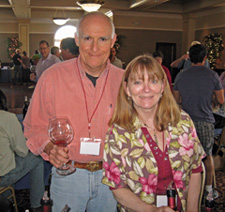 |
Muns 2009 Pinot Noir, Estate, Santa Cruz Mountains. Medium-light color, this showed upfront black cherry and plum aromas along with earth, fresh herbs, and notes of baking spice. Medium-light bodied, the tannins were noticeable but refined, nice.
Muns 2011 Pinot Noir, “Native Yeast,” Estate, Santa Cruz Mountains. Fermented with native yeast and aged in neutral oak. Medium-light ruby, displaying more earth and herb components with somewhat primary cherry fruit in support. Fairly light but lively on the palate with moderate tannins, this still needs time to develop.
Muns 2008 Pinot Noir, Estate, Santa Cruz Mountains. Similar color to the first two wines, displaying ripe black cherry, earth, and a touches of spice and vanilla on the nose. Richer mouthfeel with refined tannins.
Comments: At 2,600-foot elevation, Muns is the highest Pinot vineyard in the area, planted from 1998-2005 with 114, 115, 667, and 777 clones. Muns uses mostly Hungarian oak barrels – I thought they worked better with these wines than some of the others at the event.
Nicholson Vineyards
Nicholson 2009 Pinot Noir, Santa Cruz Mountains. Medium-light color, with black cherry, earth, and forest floor aromas, plus a touch of tea leaf. Medium-light weight with fairly grippy tannins on the finish.
Nicholson 2010 Pinot Noir, “Brooks Block,” Estate, Santa Cruz Mountains. Slightly deeper ruby color, this had less upfront fruit but a distinct savory, minerally character along with black cherry and raspberry, earth, and spice on the nose. Medium-bodied with a broad mouthfeel and moderate tannins, nice.
Nicholson 2010 Pinot Noir, “Estate Reserve,” Santa Cruz Mountains. From selected lots given extra aging in new oak. Medium color, the vanilla/oak component led the way but with plenty of raspberry and plum fruit and spice as well. Richer on the palate with medium tannins.
Comments: The estate vineyard is located in the Corralitos area.
Pelican Ranch Winery
Pelican Ranch 2010 Pinot Noir, Amaya Ridge Vineyard, Santa Cruz Mountains. From 113, 114, 115, and Saintsbury clones, aged in French oak. Light color, earthy red fruits and spice on the nose. Medium-light weight with moderate but refined tannins.
Pelican Ranch 2009 Pinot Noir, Meadowridge Vineyard, Santa Cruz Mountains. From 115, 667, and 777 clones, aged in French oak. Medium-light color, with oaky aromas along with black cherry and plum. The woody/oaky character continued on the palate through to the finish.
Comments: The wines were all bottled under screwcap, the only screwcap wines I spotted at the tasting.
Pleasant Valley Vineyards
Pleasant Valley 2009 Pinot Noir, “Dylan David,” Lester Family Vineyard Thelma-Henrietta Block, Santa Cruz Mountains. All 115 clone. Medium-light garnet color, showing higher-toned cherry, spice, and earth. Lighter-bodied with a moderately tannic finish.
Pleasant Valley 2010 Pinot Noir, “Dylan David,” Lester Family Vineyard Willa-Louise Block, Santa Cruz Mountains. All 667 clone. Slightly darker color with deeper fruit aromas, spice, and vanilla/oak on the nose. Bigger and richer mouthfeel with medium tannins.
Pleasant Valley 2010 Pinot Noir, “Dylan David Reserve Cuvée,” Lester Family Vineyard, Santa Cruz Mountains. From 60% 115 clone and 40% 667 clone. Medium-light color, this displayed black cherry, earth, spice, and sweet oak aromas. Medium-bodied with a grippier tannic finish.
Comments: The wines are aged entirely in Seguin Moreau French oak barrels, about 50% new.
Santa Cruz Mountain Vineyard
Santa Cruz Mountain Vineyard 2009 Pinot Noir, Bailey's Branciforte Ridge Vineyard, Santa Cruz Mountains. From 115 and 667 clones planted in 1999. Medium-light color, with ripe cherry and raspberry, spice, and forest floor. Medium weight on the palate with a moderately tannic finish.
Santa Cruz Mountain Vineyard 2010 Pinot Noir, Branciforte Creek Vineyard, Santa Cruz Mountains. From Pommard clone vines planted in 1988. Medium-light color, with brighter red fruits with lots of spice, plus earth and a slightly stony mineral note. Lively texture and good structure, with big but fairly refined tannins and a long finish, nice.
Comments: I have usually preferred the Branciforte Creek bottling of these two wines, and this year was no different.
Sante Arcangeli Family Wines
Sante Arcangeli 2011 Pinot Noir, “Corralitos Duet,” Santa Cruz Mountains. Sourced from Split Rail and Fog’s Edge vineyards. Medium-light garnet color, featuring raspberry, earth, and hints of flowers, spice, and sweet oak. Medium-light bodied with juicy acidity and moderate tannins, nice.
Sante Arcangeli 2012 Pinot Noir, Split Rail Vineyard, Santa Cruz Mountains (barrel sample). Medium-light color, with still-primary fruit dominating along with lots of spice and vanilla/oak in this barrel sample. Showing grippy tannins on the finish, it was hard to tell where this will be heading as it develops.
Comments: A promising newcomer to the Corralitos Pinot scene, it should be interesting to follow this producer in the future.
Savannah-Chanelle Vineyards & Winery
Savannah-Chanelle 2010 Pinot Noir, Muns Vineyard, Santa Cruz Mountains. From 114, 115, 667, and 777 clones. Fairly light color, this was fruit-forward with bright black cherry and plum, along with spice and vanilla/oak and lightly floral notes. Medium-bodied with a big, tannic finish.
Savannah-Chanelle 2010 Pinot Noir, Regan Vineyard, Santa Cruz Mountains. Medium-light color, with ripe and higher-toned upfront red fruit, spice, earth, and sweet oak on the nose. Richer mouthfeel and juicy acidity with more refined tannins.
Comments: The wines are aged in Hungarian oak and the bottles use synthetic cork closures. The Muns Vineyard bottling was my favorite of the two.
Silver Mountain Vineyards
Silver Mountain 2008 Pinot Noir, Miller Hill Vineyard, Santa Cruz Mountains. From 115 and 667 clone vines planted in 1997, aged mostly in Hungarian oak. Medium-light color, showing higher-toned cranberry and strawberry fruit, spice, and vanilla/oak. Medium-bodied with fairly grippy tannins.
Silver Mountain 2008 Pinot Noir, Muns Vineyard, Santa Cruz Mountains. From 114, 115, 667, and 777 clones, aged in 33% new Hungarian oak. Slightly darker color, this featured black cherry, spice, and vanilla/oak aromas along with some dried herb notes. Medium weight with a big tannic finish.
Silvertip Vineyards
Silvertip 2008 Pinot Noir, Estate, Santa Cruz Mountains. Entirely 828 clone. Medium-light color, with ripe darker fruit aromas, herbs, and spicy oak. Big and structured on the palate, with a lingering finish.
Silvertip 2009 Pinot Noir, Estate, Santa Cruz Mountains. Mostly 115 and 828 clones, with a little Pommard and 667. Medium-light garnet color, showing ripe raspberry and lots of spice, plus notes of dried herbs and earth, and better-integrated oak than the 2008 bottling. Medium weight with a slightly chewy texture and a tasty finish, nice.
Comments: A newer producer with an estate vineyard planted in 1999 at about 1,700-foot elevation on the western side of Summit Road.
Sonnet Wine Cellars
Sonnet 2009 Pinot Noir, Muns Vineyard, Santa Cruz Mountains. Medium-light color, with oak and spice aromas upfront, followed by bright cherry, herbs, and earth. Medium-bodied with a moderately big tannic finish.
Sonnet 2010 Pinot Noir, Muns Vineyard, Santa Cruz Mountains. Medium-light color, this was less fruit-forward, with earth, red fruits, a saline/minerally quality, and better-integrated oak. Medium weight on the palate and lively, with somewhat chewy tannins.
Comments: The wines were aged in Hungarian oak. The 2010 bottling was my clear favorite of the two.
Storrs Winery and Vineyards
Storrs 2009 Pinot Noir, Santa Cruz Mountains. Sourced entirely from Christie Vineyard in the Corralitos area, aged in French oak. Medium-light color, the vanilla/oak component dominated the nose, with cherry and spice in the background. Medium-light bodied with a moderately grippy finish.
Storrs 2008 Pinot Noir, Christie Vineyard, Santa Cruz Mountains. Slightly lighter color, this also showed lots of oak and spice aromas, along with red berries and rhubarb and hints of earth and herbs. Broader texture than the 2009 bottling with medium tannins.
Thomas Fogarty Winery & Vineyards
Thomas Fogarty 2010 Pinot Noir, Santa Cruz Mountains. Sourced from seven vineyards, including 34% from the estate vineyard. Fairly light color, featuring red fruits, herbs, earth, and black pepper. Medium-light weight on the palate with a touch of sweet oak on the finish.
Thomas Fogarty 2011 Pinot Noir, Santa Cruz Mountains. To be released in June. Medium-light color, this displayed a more complex nose that included fresh herbs, red berries, flowers, and a stony, minerally component. Medium-light bodied with more texture in the mouth than the 2010 bottling and finishing with refined tannins, nice.
Thomas Fogarty 2010 Pinot Noir, Rapley Trail Vineyard, Estate, Santa Cruz Mountains. Includes fruit from all five blocks of Rapley Trail, aged in 40% new French oak. Medium-light ruby color, with more intense aromas of dried herbs, flowers, minerals, and earth along with strawberry and raspberry fruit and hints of spicy oak. A bit richer on the palate than the first two wines, with lively acidity and a lingering finish, nice.
Comments: A strong trio of wines from Thomas Fogarty.
Villa del Monte Winery
Villa del Monte 2010 Pinot Noir, Regan Vineyard, Santa Cruz Mountains. Aged in both French and American oak. Medium-light color, showing higher-toned red fruits and spice. Medium-bodied with milder tannins.
Woodside Vineyards
Woodside 2010 Pinot Noir, Estate, Santa Cruz Mountains. Sourced from the winery’s own vineyard and other nearby vineyards that they manage. Medium-light color, with ripe raspberry and cherry aromas, spice, and vanilla/oak. Moderately rich mouthfeel with a smoother texture and fairly mild tannins.
|



